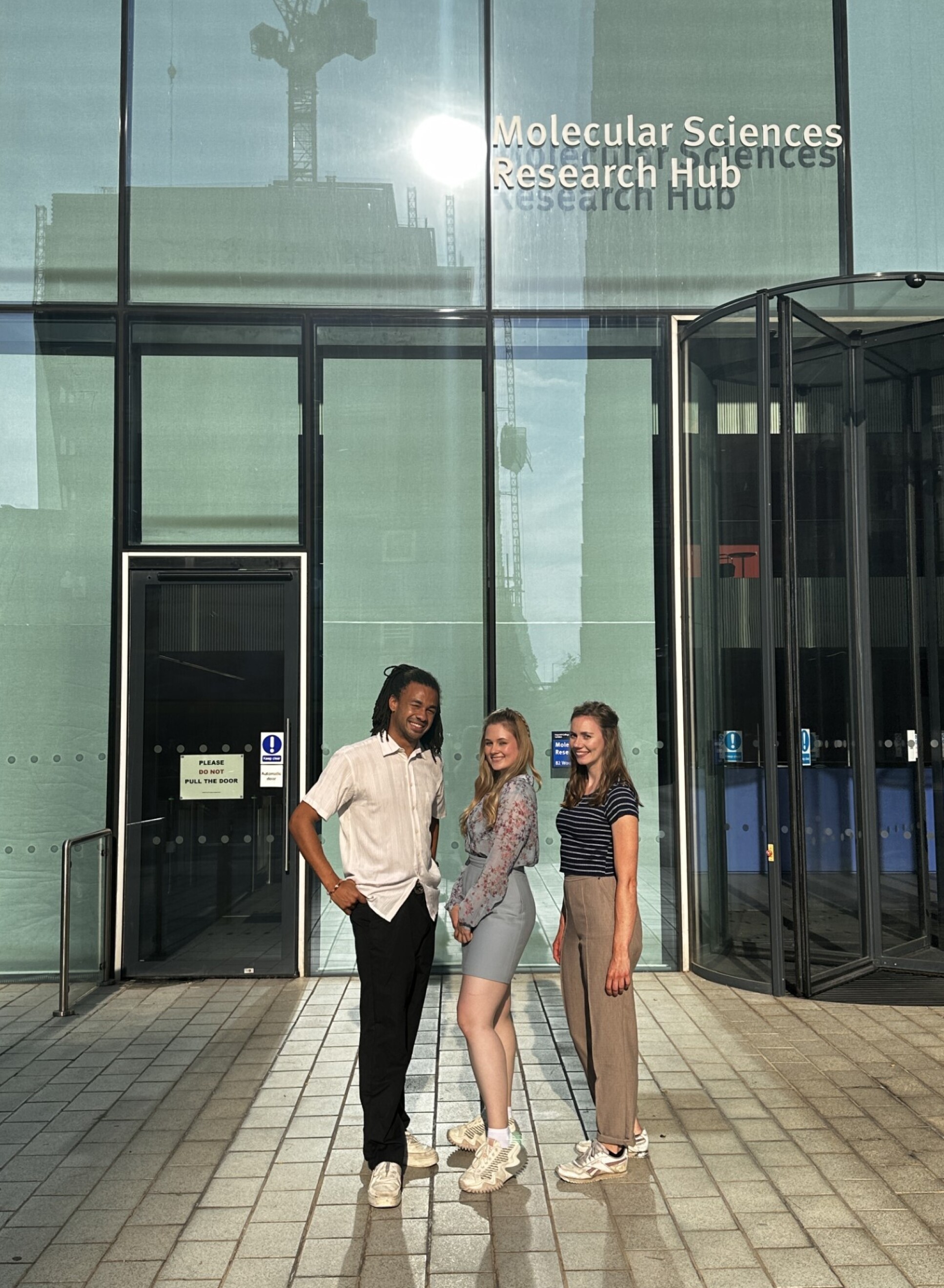ICL Postgraduate Symposium 2023 Winners


Congratulations to our MRes DDD students: Najma Hassan & Jaskirat Kaur, and our MRes + PhD students: Anna Kukushkina & Amy McIntosh on their talks!
Congratulations to our MRes in Drug discovery and development students: Najma Hassan and Jaskirat Kaur, and our MRes + PhD students: Anna Kukushkina and Amy McIntosh on winning prizes for their talks!
This year’s postgraduate symposium showcased a multitude of research talks across different themes around chemical biology and drug discovery. Below are the short abstracts from the prize-winning talks.
Jaskirat Kaur, (MRes Drug Discovery & Development)
“AND-gated protease cleavable antibody-drug conjugate (ADC) linker”
Peptide motifs constitute the predominant class of cleavable linkers in clinically approved antibody-drug conjugates (ADCs). However, these amino acid sequences are often susceptible to extracellular enzyme cleavage, such as elastase secreted from differentiating neutrophils. This susceptibility results in the systemic release of the cytotoxic payload, causing a reduction in the therapeutic index due to dose-limiting toxicities like myelosuppression. The recent emergence of dual-enzyme cleavable linkers offers a promising remedy by providing twofold selectivity for payload release within patients. This study addresses the non-specific payload release by introducing an innovative AND-gate protease cleavable linker concept.
Najma Hassan, (MRes Drug Discovery & Development)
“Optimisation of inhibitors against the Schistosoma mansoni VKR2 Kinase Domain”
Schistosomiasis is a neglected tropical disease that is one of the most socioeconomically devastating; currently affecting over 250 million people worldwide. The treatment of this disease depends on the mass administration of populations with the only commercially available drug, Praziquantel, that is capable of killing the causative agent of schistosomiasis- blood flukes of genus Schistosoma. This control strategy, however, leads to concerns of possible resistance of the Schistosoma worms to Praziquantel, highlighting the importance of novel therapeutics that can effectively treat this disease. This study focuses on the optimisation of the identified inhibitor to increase its potency by modifying groups that may be involved in interactions within the kinase domain, as identified via in silico docking. Synthesis followed by biological evaluation of analogues of the identified inhibitor allowed for the determination of structure-activity relationships, which were further explored through in silico docking. Improvements in potency were exhibited by three analogues, presenting an opportunity for further lead development.
Anna Kukushkina, (MRes Chemical Biology and Bio-Entrepreneurship)
“The Development of the Nanoluciferase-Proximity Labelling (NLProx) Platform for Investigting Intractable Targets”
Proximity labelling (PL) is a high-resolution technique to study the interactome of a protein of interest. Here we present a novel platform combining a split-nanoluciferase system with proximity labelling (NLProx) to investigate the interactomes of intractable targets at their endogenous level. A PL enzyme was genetically fused to LgBiT and transiently expressed in a stable cell line containing HiBiT peptide knock-in at the endogenous loci of a protein of interest. We used STAG1 protein and TurboID labelling enzyme as proof of concept to demonstrate the executability of the system. Making use of the luminescent property of nanoluciferase, we developed an assay assessing the labelling enzyme recruitment to STAG1 through HiBiT-LgBiT recombination.
Amy McIntosh, (MRes Chemical Biology and Bio-Entrepreneurship)
“The development of ligand-directed proximity labelling probes to study RNA-protein interactions.”
The importance of RNA to cell health is apparent with its well-known role as a messenger of genetic information. However, RNAs have a much more significant role in post-translational gene regulation through interactions with RNA-binding proteins (RBP). Abnormalities in these interactions are associated with various diseases, including neurodegenerative diseases and cancers. By unravelling these RNA-protein networks, a greater understanding of cellular processes and their involvement in disease states will be gained. Current methods to identify interactors of specific RNA transcripts suffer from various limitations such as high background labelling and poor temporal resolution. To address these, we propose a complementary ligand directed proximity labelling approach to aid the mapping of these protein interactions. Proximity labelling is a powerful tool that selectively labels biomolecules within close proximity of a desired target. Through a localized catalyst, reactive species that can interact covalently are generated near a desired target allowing weak and transient interactions can be captured with minimimal offtarget labelling. In this work two photocatalytic probes to identify the interacting partners of the SMN2 pre-mRNA were designed as a proof-of-concept study. The synthetic route to a shared probe intermediate and control compound was successfully optimised allowing the ease of later scale up and photocatalyst conjugation. This control compound was then used for the early optimisation of an RT-qPCR assay which will be required to confirm target engagement of the probes.
MRes + PhD Chemical Biology Symposium Prize Winners
Well done to Jaskirat, Najma, Anna, and Amy!
Article text (excluding photos or graphics) © Imperial College London.
Photos and graphics subject to third party copyright used with permission or © Imperial College London.